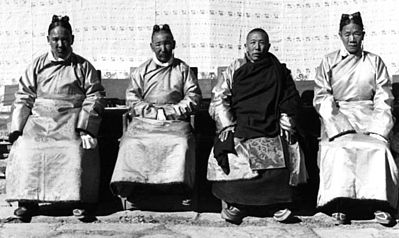Kashag

The Kashag (

As specified by the
The function of the council was to decide government affairs collectively,
In August 1929, the Supreme Court of the Central Government stated that before the publication of new laws, laws in history regarding Tibet, regarding reincarnation of rinpoches, lamas were applicable.[6]
On 28 March 1959, Zhou Enlai, the premier of the People's Republic of China (PRC), formally announced the dissolution of the Kashag.[7][8]
Ministries

Headed by the council was the government administration, divided into
In Constitution of Tibet (10 March 1963 – 13 June 1991)
On 29 April 1959, the
In the Charter of Tibetans in Exile (14 June 1991 – 14 March 2011)
In 1974, the 14th Dalai Lama rejected calls for Tibetan independence.[10] In 1991, the Charter of Tibetans in Exile was created, and the Dalai Lama became head of the Tibetan Administration and the executive functions for Tibetans-in-exile. Kashag was created and it consisted of Chief Kalon and seven Kalons.
In the Charter of Tibetans in Exile (29 May 2011 – present)
In March 2011, at 71 years of age, he decided not to assume any political and administrative authority, the Charter of Tibetans in Exile was updated immediately in May 2011, with Kashag consisting of Sikyong and no more than seven Kalons.
According to
- Penpa Tsering – Sikyong
- Penpa Tsering – Acting Kalon for Home
- Penpa Tsering – Acting Kalon for Religion & Culture
- Norzin Dekyi – Kalon for Information & International Relations
- Kalon Tharlam Dolma Changra – Kalon for Education
- Dolma Gyari – Kalon for Security
- Penpa Tsering – Acting Kalon for Finance
- Penpa Tsering – Acting Kalon for Health
References
- ^ Dawa Norbu, China's Tibet Policy
- ^ ISBN 978-7-80113-304-5.
- ^ Seventh Dalai Lama Kelsang Gyatso Archived 2010-07-01 at the Wayback Machine
- ISBN 81-7436-085-9.
- ^ Tsepon W. D. Shakabpa, Tibet, a Political History (New Haven: Yale, 1967), 150.
- ^ "【边疆时空】喜饶尼玛 李双|国民政府管理藏传佛教活佛措施评析_蒙藏". www.sohu.com. Retrieved 2023-08-11.
- ^ https://sites.fas.harvard.edu/~hpcws/jcws.2006.8.3.pdf Archived 2017-01-29 at the Wayback Machine [bare URL PDF]
- S2CID 57566391.
- ISBN 9787801132987.
- ^ "The Dalai Lama Has Been the Face of Buddhism for 60 Years. China Wants to Change That". Time. 2019-03-07. Retrieved 2023-08-11.
- ^ Backman, Michael (2007-03-23). "Behind Dalai Lama's holy cloak". The Age. Retrieved 2010-11-20.
- ^ 達賴喇嘛和班禪額爾德尼周圍的隨從官員,過去都是他們的親屬,如達賴喇嘛的叔父和班禪額爾德尼的父親班丹團主,都是私人升任,又如達賴喇嘛之胞兄洛桑格登主巴,依仗勢力多行不法。今後應依西藏各階層及扎什倫布僧俗人民之願望,在達賴喇嘛和班禪額爾德尼在世時,其親屬人員不准參預政事。達賴、班禪圓寂後,如果還有親屬,可以根據他們的技能給予適當的職務。
See also
- Ganden Phodrang
- Chinese expedition to Tibet (1720)
- Tibet under Qing rule
- Dual system of government
